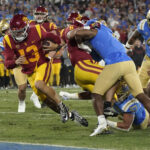Commentary on Pac-12 developments on and off the field …
Falling: Pac-12 presidents and chancellors
Yet more evidence has surfaced this week to suggest conference leadership is hesitant to plunge into the world of compensation for athletes.
Last June, the Supreme Court ruled in Alston vs. NCAA that universities could provide up to $5,980 annually in academic-related compensation. This could come in the form of equipment and supplies or payments in exchange for classroom achievement.
Within months, the SEC presidents voted to allow schools to determine their methods for providing academic rewards; the conference then went public with the collective show of support.
Thus far, the Pac-12 has remained quiet. A conference source said the presidents, as a group, are wary of following the SEC’s path.
“(Commissioner George) Kliavkoff is doing as good a job as anyone could do under the circumstances,” the source said, “but it didn’t have the support.”
More details on the topic surfaced this week, when ESPN published a list of schools that have “plans in place” to provide academic bonuses this year.
Only three Pac-12 schools are committed to the process of rewarding players for classroom achievement, per ESPN: Colorado, Washington and Oregon.
Over in the SEC, there are 10. (If you include Oklahoma and Texas, which are set the join the league in a few years, the total rises to 12 of 16 schools.)
“We’re limiting ourselves,” the Pac-12 source said.
College athletics entered a new era last summer with the legalization of compensation to athletes for academic performance (via the Alston case) and through promotional opportunities in the private sector (name, image and likeness).
Both carry massive recruiting implications even if they aren’t supposed to be used as recruiting inducements.
In each case, Pac-12 campuses are moving more deliberately than many peers:
Only three schools reportedly are set to make cash payments for academic achievement, and several lack the donor collectives that underpin NIL endeavors.
For both matters, willpower begins at the top, with the presidents and chancellors.
Rising: ASU football recruiting
The Sun Devils have struggled for momentum over the past nine months with the NCAA investigation suffocating the program and high school recruiting at rock bottom.
But finally, there are encouraging signs in Tempe: The Sun Devils will have the support of a donor collective to provide NIL opportunities for athletes, according to The Athletic.
“Although we can’t have direct involvement,” a school official told the outlet, “we encourage the prospect of that potentially happening here soon.”

Donor collectives are sprouting up across the country, all of them intended to create opportunities for players to receive compensation in exchange for endorsement opportunities.
At Texas, for instance, a group called ‘Horns with a Heart’ is reportedly offering each offensive lineman $50,000 to support charitable causes.
Such endeavors are permissible under NIL, so long as the collective works independently of the university.
Some collectives have high standards; others constitute pay-for-play schemes with a thin veneer of legal legitimacy that are used as recruiting inducements. But without the collectives, recruiting in the NIL world will become increasingly difficult.
Arizona State is behind on this matter and, in fact, whiffed strategically on two fronts:
— The Sun Devils devoted immense resources to their ballyhooed New Leadership Model under coach Herm Edwards. A few years later, it collapsed on itself with the recruiting scandal.
— While ASU pursued the doomed leadership model, then dealt with the fallout, much of major college football worked toward a strategic end-game that could materially impact success: NIL and all the trappings, including donor collectives.
Arizona, for example, has two donor collectives and an NIL exchange, all designed to foster endorsement opportunities for athletes.
(Technically, the collectives are unaffiliated with the universities. In reality, one arm is keenly aware of what the other is doing.)
The ASU donor collective could be limited until the NCAA case is resolved. But at that point, will help the Sun Devils recharge more effectively than they would without the donor support.
These days, any positive development in Tempe is a big deal.
Falling: Washington State basketball
For the most part, the comings and goings in Pullman have trended favorably for coach Kyle Smith in his 25 months on the job.

An exception came this week, with the news that wing Noah Williams is entering the transfer portal.
Williams was arguably WSU’s best player in 2020-21 — he received all-Pac-12 honorable mention distinction — but his production declined this season.
We’ll reserve final judgment on Williams’ departure until the roster spot is filled, but the Cougars will be hard pressed to find a newcomer capable of making a greater impact. (Williams averaged 10 points and 26 minutes per game.)
On a broader level, the development hurts the Pac-12.
The conference cannot be judged solely by the strength of its best teams. Quality depth matters, and attrition on teams that could reasonably be considered NCAA bubble contenders — WSU, for instance — can limit the number of at-large berths.
Rising: UCLA basketball
We’re slowly gaining clarity on the non-conference schedules for 2022-23 that will play a key role in determining NET rankings and, therefore, success or failure on Selection Sunday.
The Bruins on Tuesday revealed their participation in the Maui Invitational, along with a stellar field that features Gonzaga, Kansas, Marquette, Purdue, Syracuse and Tennessee, plus Chaminade.
UCLA could face three teams that qualify for the NCAA on a single weekend, a potential jackpot for the Pac-12 given the multiplier effect within the NET rankings.
Two or three teams with Quadrant I wins and superior schedule strength can prop up the conference once intra-league play begins.
Rising: USC football
A development 2,000 miles away left the Trojans as the last team standing — in an impressive category
Notre Dame recently announced its opener for the 2023 season:
Tennessee State, the first opponent in school history from one of the Historically Black Colleges or Universities.
The HBCUs compete at the Football Championship Subdivision level (formerly I-AA), leaving USC as the only major college program in the country that has never played an FCS opponent.
Until recently, USC, UCLA and Notre Dame shared that distinction.
Then UCLA scheduled Alabama State for 2022 and North Carolina Central for 2023.
Now, Notre Dame has booked Tennessee State for ’23.
There’s no indication the Trojans will change course and add FCS opponents.
If anything, being the lone holdout will make them more resolute.
Support the Hotline: Receive three months of unlimited access for just 99 cents. Yep, that’s 99 cents for 90 days, with the option to cancel anytime. Details are here, and thanks for your support.
*** Send suggestions, comments and tips (confidentiality guaranteed) to pac12hotline@bayareanewsgroup.com or call 408-920-5716
*** Follow me on Twitter: @WilnerHotline
*** Pac-12 Hotline is not endorsed or sponsored by the Pac-12 Conference, and the views expressed herein do not necessarily reflect the views of the Conference.
Related posts:
 Hotline mailbag: Impact of UC regents’ delay, options for the Pac-12, ranking the coaches and why the football brands matter
Hotline mailbag: Impact of UC regents’ delay, options for the Pac-12, ranking the coaches and why the football brands matter

Southern California quarterback Caleb Williams (13) (AP Photo/Mark J. Terrill)
Pac-12 rewind: Northwest dominance, USC survival and a Big Game rally highlight Week 12 Wilner Hotline: Colorado hires Deion Sanders: A spectacular move by the Buffaloes, for better or worse
Wilner Hotline: Colorado hires Deion Sanders: A spectacular move by the Buffaloes, for better or worse
 Hotline mailbag: Timing for media rights and expansion, SDSU vs. SMU, night kickoffs, CFP matters, the ‘Berkeley tax’ and more
Hotline mailbag: Timing for media rights and expansion, SDSU vs. SMU, night kickoffs, CFP matters, the ‘Berkeley tax’ and more


